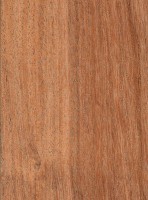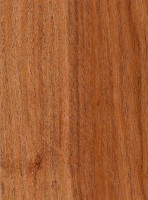 |
Common Name(s): Nandubay, Algarrobillo Scientific Name: Prosopis affinis Distribution: South America Tree Size: 20-40 ft (6-12 m) tall, 1-2 ft (.3-.6 m) trunk diameter Average Dried Weight: 63 lbs/ft3 (1015 kg/m3) Specific Gravity (Basic, 12% MC): .83, 1.02 Janka Hardness: 2,750 lbf (12,230 N)* *Estimated hardness based on specific gravity Modulus of Rupture: 6,430 lbf/in2 (44.3 MPa) Elastic Modulus: 1,420,000 lbf/in2 (9.79 GPa) Crushing Strength: No data available Shrinkage: No data available |
Color/Appearance: Heartwood tends to be a yellowish brown to dark brown, which darkens with age. Sapwood tends to be narrow and is a pale yellow color.
Grain/Texture: Nandubay has a medium to coarse texture and a slight natural luster. Grain tends to be straight or wavy.
Endgrain: No data available.
Rot Resistance: Nandubay is considered very durable regarding decay resistance, and is used for posts and poles.
Workability: Working properties are largely dictated by the quality of the wood itself. Mesquite that is clear and free from defects is easy to work with hand and machine tools, but irregular grain or knots can be challenging. Glues, turns, and finishes well.
Odor: No characteristic odor.
Allergies/Toxicity: Woods in the Prosopis genus have been reported to cause skin irritation. See the articles Wood Allergies and Toxicity and Wood Dust Safety for more information.
Pricing/Availability: No data available.
Sustainability: This wood species is not listed in the CITES Appendices, but is reported by the IUCN as being data deficient.
Common Uses: Flooring, firewood, turned objects, cabinetry, and furniture.
Comments: Nandubay is considered an invasive species in some parts of Paraguay.
 |
 |





Hello! Ñandubay is native here and I work with it quite often. Here is an example of a ñandubay box with Itin top and bottom. The finial is cocuswood.